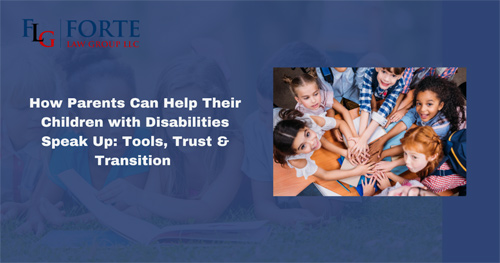As a special education attorney at Forte Law Group here in Connecticut, I work closely with families who want the best for their children with disabilities. A recent message asked a powerful question:
“Teachers and parents: How can we support youth in speaking up for their needs?”
The answer comes down to three things:
Tools, Trust, and Transition. Let’s break these down into what every parent should know and do.

Tools: Help Your Child Speak Up with Confidence
Kids don’t just “know” how to advocate for themselves—they have to be taught. Start by giving them the right tools.
- Self-advocacy skills – Students with disabilities benefit from structured support. Starting around age 16, schools must provide transition assessments. These help identify strengths, interests, and needs to create a personalized plan for education, employment, and daily life. This is a legal requirement under the IDEA (Individuals with Disabilities Education Act).
- Technology and anonymous reporting tools – Apps or school-based tools that allow students to report concerns can be great resources. These systems help students speak up—even when they don’t feel comfortable talking face-to-face. Ask your school if they offer anything like this and talk to your child about how to use them.
Trust: Build a Safe Space for Honest Conversations
Your child needs to feel safe speaking up—and that starts at home.
- Keep communication open – Ask questions like, “What do you do when you need help?” or “What’s hard for you at school?” These conversations build trust and emotional safety.
- Teach them to be an upstander – Show your child how to take action if they see someone being treated unfairly. This builds courage and confidence in using their voice.
- Partner with your school – Learn how your child’s school system works. Know who to talk to, how to ask for help, and what your child’s rights are. The more informed you are, the more confident you’ll feel—and your child will learn advocacy by watching you.
Transition: Plan Early for Life After High School
Transition planning is one of the most important—and most overlooked—parts of a child’s education plan.
- Start early – By law, transition planning should begin by age 16. This includes setting goals and identifying supports for life after high school—college, work, independent living, and more.
-
Involve your child in IEP meetings – Students are legally allowed to attend and participate in their own IEP meetings. This helps them learn to speak up, make decisions, and set personal goals.
-
Connect with community services – Work with your school to bring in agencies that can help with job training, assistive technology, or adult disability services. These partnerships can make a big difference in your child’s future.
What You Can Do as a Parent
Tools
-
Teach your child how to ask for help
-
Use apps or tools that help them express their needs
-
Request assessments that show their strengths and challenges
Trust
-
Have regular, open conversations
-
Model speaking up by asking questions at school
-
Support your child’s voice, even if it’s different from your own
Transition
-
Don’t wait—start planning by age 16 (or sooner)
-
Encourage your child to join IEP meetings
-
Build connections with adult service providers early
Why This Matters
Everything discussed here ties directly to your child’s legal rights. Under federal law (IDEA), your child has the right to be part of their own transition planning. You, as a parent, have the right to understand and advocate for what your child needs.
When families, schools, and communities work together—and when students are given real tools and safe spaces to speak up—they are more likely to succeed after high school.
At Forte Law Group, we help families across Connecticut understand their rights, navigate the IEP process, and prepare their children for successful futures.
If you need help with special education planning, the team is here to support you.
Jeffrey Forte
Special Education Attorney



